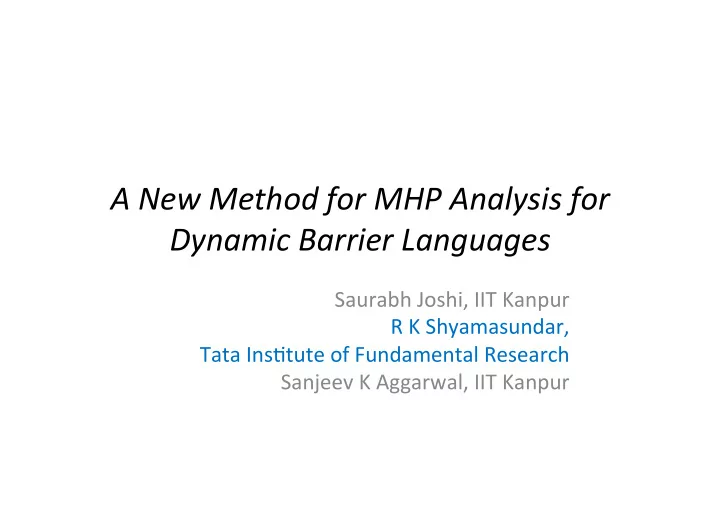

A ¡New ¡Method ¡for ¡MHP ¡Analysis ¡for ¡ Dynamic ¡Barrier ¡Languages ¡ Saurabh ¡Joshi, ¡IIT ¡Kanpur ¡ R ¡K ¡Shyamasundar, ¡ Tata ¡Ins7tute ¡of ¡Fundamental ¡Research ¡ Sanjeev ¡K ¡Aggarwal, ¡IIT ¡Kanpur ¡
Problem ¡ • Given ¡a ¡concurrent ¡program ¡ P , ¡ ¡ mhp(S,S’)==true, ¡ ¡ two ¡statements ¡ S ¡and ¡ S’ ¡(or ¡instances ¡thereof) ¡ may ¡execute ¡in ¡parallel ¡in ¡some ¡execu7on ¡of ¡ program ¡ P ¡ – A ¡statement ¡inside ¡a ¡loop ¡gives ¡rise ¡to ¡mul7ple ¡ instances ¡ ¡ • From ¡now ¡on ¡it ¡is ¡denoted ¡as ¡ S||S’ ¡ and ¡!(S||S’) ¡ • More ¡helpful ¡in ¡op7miza7on ¡and ¡debugging ¡if ¡we ¡ can ¡establish ¡ !(S||S’) ¡
General ¡MHP ¡Analysis ¡ ¡ • NP-‑complete ¡under ¡certain ¡restric7ons ¡ (Taylor, ¡Acta ¡Informa7ca ¡1983) ¡ • Un-‑decidable ¡if ¡you ¡take ¡termina7ons ¡ • Important ¡for ¡Compiler ¡Op7miza7ons ¡and ¡ checking ¡interference ¡freedom ¡in ¡concurrent ¡ fragments ¡
Dynamic ¡Barrier ¡Languages ¡ • async ¡S ¡ : ¡Spawns ¡a ¡new ¡ac7vity ¡which ¡will ¡ execute ¡ S ¡ ¡ • finish ¡S ¡ ¡ : ¡When ¡all ¡the ¡ac7vi7es ¡transi7vely ¡ spawned ¡from ¡ S ¡finishes, ¡only ¡then ¡this ¡ statement ¡is ¡said ¡to ¡finish ¡its ¡execu7on ¡ • MHP ¡for ¡Dynamic ¡Barrier ¡Languages ¡ ¡ – X10 ¡(PGAS), ¡Habenaro ¡ – Shivali ¡Agrawal, ¡Raj ¡Kishore ¡Barik, ¡Vivek ¡Sarkar, ¡RK ¡ Shyamasundar, ¡PPoPP ¡2007 ¡ ¡
Dynamic ¡Barrier ¡Languages ¡ • Clocks ¡: ¡A ¡dynamic ¡barrier ¡construct, ¡where ¡ ac7vi7es ¡can ¡join ¡and ¡leave ¡the ¡barrier ¡ dynamically. ¡ – Ac7vi7es ¡par7cipa7ng ¡in ¡a ¡barrier ¡synchroniza7on ¡ is ¡not ¡known ¡at ¡the ¡7me ¡of ¡barrier ¡crea7on ¡
Clocks ¡ • c=new ¡clock() ¡ : ¡new ¡clock ¡is ¡created ¡and ¡the ¡ current ¡ac7vity ¡is ¡registered ¡with ¡the ¡clock ¡ • next ¡ : ¡barrier ¡synchroniza7on ¡ – Control ¡does ¡not ¡proceed ¡beyond ¡this ¡point, ¡un7l ¡ all ¡ac7vi7es ¡sharing ¡a ¡clock ¡with ¡this ¡ac7vity ¡ reaches ¡corresponding ¡synchroniza7on ¡point ¡
Clocks ¡ • c.drop() ¡ : ¡ac7vity ¡de-‑registers ¡itself ¡from ¡clock ¡ c ¡ – Once ¡an ¡ac7vity ¡drop ¡out ¡of ¡the ¡clock, ¡it ¡can ¡not ¡re-‑ register ¡again ¡on ¡that ¡clock ¡ • async ¡(c1,c2,…cn) ¡S ¡ : ¡spawns ¡an ¡ac7vity ¡ registered ¡on ¡clocks ¡c1,c2,…,cn ¡ – This ¡is ¡the ¡only ¡other ¡way ¡to ¡register ¡with ¡a ¡clock ¡ apart ¡from ¡crea7ng ¡a ¡clock ¡ – Parent ¡ac7vity ¡has ¡to ¡be ¡registered ¡on ¡c1,…,cn ¡ – A ¡clocked ¡ async ¡can ¡not ¡be ¡in ¡the ¡immediate ¡scope ¡of ¡ finish ¡
MHP ¡Analysis ¡Extensions ¡ • Harshit ¡Shah, ¡RK ¡Shyamasundar, ¡Pradeep ¡ Varma, ¡IPDPS ¡2009 ¡ • Realized ¡in ¡the ¡context ¡of ¡CSSA ¡(concurrent ¡ single ¡sta7c ¡assignment ¡of ¡barrier ¡ synchroniza7on ¡languages) ¡by ¡construc7ng ¡ hierarchical ¡clock ¡control ¡graph. ¡
Why ¡a ¡new ¡method? ¡ • Earlier ¡approaches ¡directly ¡compute ¡ parallel (n) ¡ for ¡every ¡node ¡ n ¡ , ¡where ¡ parallel(n) ¡ is ¡the ¡ set ¡of ¡nodes ¡that ¡may ¡execute ¡in ¡parallel ¡to ¡ node ¡ n ¡ – It ¡does ¡not ¡retain/compute ¡order ¡between ¡two ¡ statements ¡ – Misses ¡out ¡on ¡opportuni7es ¡ – Requires ¡that ¡two ¡statements ¡share ¡a ¡barrier ¡to ¡ infer ¡ mhp(S,S’)==false ¡
Example ¡1 ¡ • Set ¡based ¡MHP ¡ Thread1 ¡ Thread2 ¡ analysis ¡only ¡infer ¡ ! ¡ ¡ S1: ¡ ¡x=v1 ¡ ….. ¡ (S1||T1) ¡ next; ¡ next; ¡ • Misses ¡on ¡ … ¡ T1: ¡x=v2; ¡ op7miza7on ¡ next; ¡ next; ¡ … ¡ … ¡ • One ¡can ¡do ¡beeer ¡ … ¡ … ¡ if ¡the ¡order ¡can ¡be ¡ …. ¡ … ¡ inferred ¡ (S1 ¡< ¡T1), ¡ … ¡ (T1 ¡< ¡S2) ¡ ¡ S2:z=v2 ¡ S2: ¡z=x ¡ ¡
Example ¡2 ¡ !(S1||P2) ¡&& ¡!(P2||T3) ¡does ¡not ¡imply ¡!(S1||T3) ¡ Thread1(c1) ¡ Thread2(c1,c2) ¡ Thread3(c2) ¡ Can ¡not ¡directly ¡infer ¡!(S1||T3) ¡in ¡absence ¡of ¡a ¡common ¡ ¡ ¡ ¡ barrier ¡ S1; ¡ P1; ¡ T1; ¡ next; ¡ next; ¡ next; ¡ S2; ¡ P2: ¡ T2; ¡ next; ¡ next; ¡ next; ¡ S3; ¡ P3; ¡ T3; ¡ ¡ (S1 ¡< ¡P2) ¡&& ¡(P2 ¡< ¡T3) ¡ è ¡(S1 ¡< ¡T3) ¡ è ¡!(S1||T3) ¡ Ordering ¡helps!! ¡ No ¡common ¡barrier ¡ (Indirect ¡Synchroniza7on) ¡ PIA: ¡only ¡approach ¡to ¡deal ¡with ¡indirect ¡synchroniza7on ¡
Solu7on? ¡ • What ¡we ¡need ¡is ¡a ¡mechanism ¡to ¡retain ¡or ¡ compute ¡order ¡between ¡two ¡statements ¡
Phase ¡Interval ¡Analysis ¡ • Compute ¡ <a,b> c ¡ ¡ for ¡each ¡statement ¡ S ¡with ¡ respect ¡to ¡some ¡reference ¡point ¡ R ¡ – Barrier ¡: ¡ c ¡ ¡ – Lower ¡bound ¡: ¡ a ¡ – Upper ¡bound ¡: ¡ b ¡ • S ¡can ¡only ¡execute ¡from ¡phase ¡ a ¡to ¡ b ¡of ¡ barrier ¡ c ¡when ¡ R ¡is ¡assumed ¡to ¡execute ¡in ¡ <0,0> ¡
Phase ¡Interval ¡Analysis ¡ <a,b> ¡s1<a1,b1> ¡ ¡<a1,b1> ¡s2 ¡ ¡<a2,b2> ¡ -‑-‑-‑-‑-‑-‑-‑-‑-‑-‑-‑-‑-‑-‑-‑-‑-‑-‑-‑-‑-‑-‑-‑-‑-‑-‑-‑-‑-‑-‑-‑-‑-‑-‑-‑-‑-‑-‑-‑-‑-‑-‑-‑-‑-‑-‑-‑-‑-‑-‑-‑-‑-‑-‑-‑-‑-‑-‑-‑ ¡(SEQ) ¡ <a,b>s1;s2 ¡<a2,b2> ¡ <a1,b1> ¡s1<a2,b2> ¡ ¡<a1,b1> ¡s2 ¡ ¡<a3,b3> ¡ -‑-‑-‑-‑-‑-‑-‑-‑-‑-‑-‑-‑-‑-‑-‑-‑-‑-‑-‑-‑-‑-‑-‑-‑-‑-‑-‑-‑-‑-‑-‑-‑-‑-‑-‑-‑-‑-‑-‑-‑-‑-‑-‑-‑-‑-‑-‑-‑-‑-‑-‑-‑-‑-‑-‑-‑-‑-‑-‑ ¡(ITE) ¡ <a,b>if ¡b ¡then ¡s1 ¡else ¡s2 ¡<min(a2,a3),max(b2,b3)> ¡ Here, ¡implicitly, ¡clocks ¡are ¡assumed ¡as ¡a ¡subscript ¡for ¡every ¡interval. ¡ ¡ One ¡has ¡to ¡calculate ¡intervals ¡with ¡respect ¡to ¡all ¡clocks. ¡
<a,b> ¡ ¡s ¡<a1,b1> ¡ -‑-‑-‑-‑-‑-‑-‑-‑-‑-‑-‑-‑-‑-‑-‑-‑-‑-‑-‑-‑-‑-‑-‑-‑-‑-‑-‑-‑-‑-‑-‑-‑-‑-‑-‑-‑-‑-‑-‑-‑-‑-‑-‑-‑-‑-‑-‑-‑-‑-‑-‑-‑-‑-‑-‑-‑-‑-‑-‑ ¡(ASYNC) ¡ <a,b>async ¡s ¡<a,b> ¡ • async ¡starts ¡a ¡new ¡control ¡flow, ¡hence ¡the ¡ statement ¡following ¡it ¡starts ¡in ¡the ¡interval ¡ <a,b> ¡
<a,b> ¡ ¡s ¡<a1,b1> ¡ -‑-‑-‑-‑-‑-‑-‑-‑-‑-‑-‑-‑-‑-‑-‑-‑-‑-‑-‑-‑-‑-‑-‑-‑-‑-‑-‑-‑-‑-‑-‑-‑-‑-‑-‑-‑-‑-‑-‑-‑-‑-‑-‑-‑-‑-‑-‑-‑-‑-‑-‑-‑-‑-‑-‑-‑-‑-‑-‑ ¡(FINISH) ¡ <a,b>finish ¡s ¡<a1,b1> ¡ • Follows ¡from ¡the ¡rule ¡for ¡async ¡ – Note ¡: ¡a ¡clocked ¡ async ¡can ¡not ¡be ¡in ¡the ¡ immediate ¡scope ¡of ¡ finish ¡
Recommend
More recommend